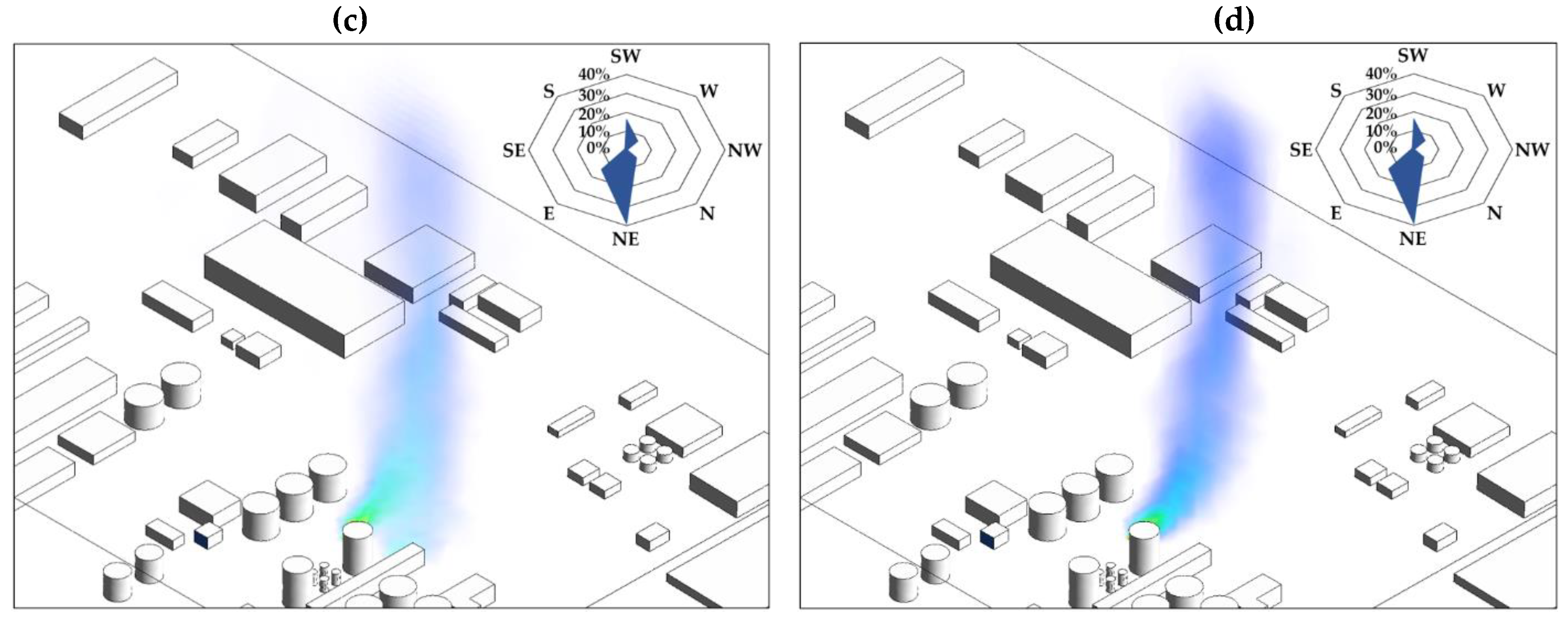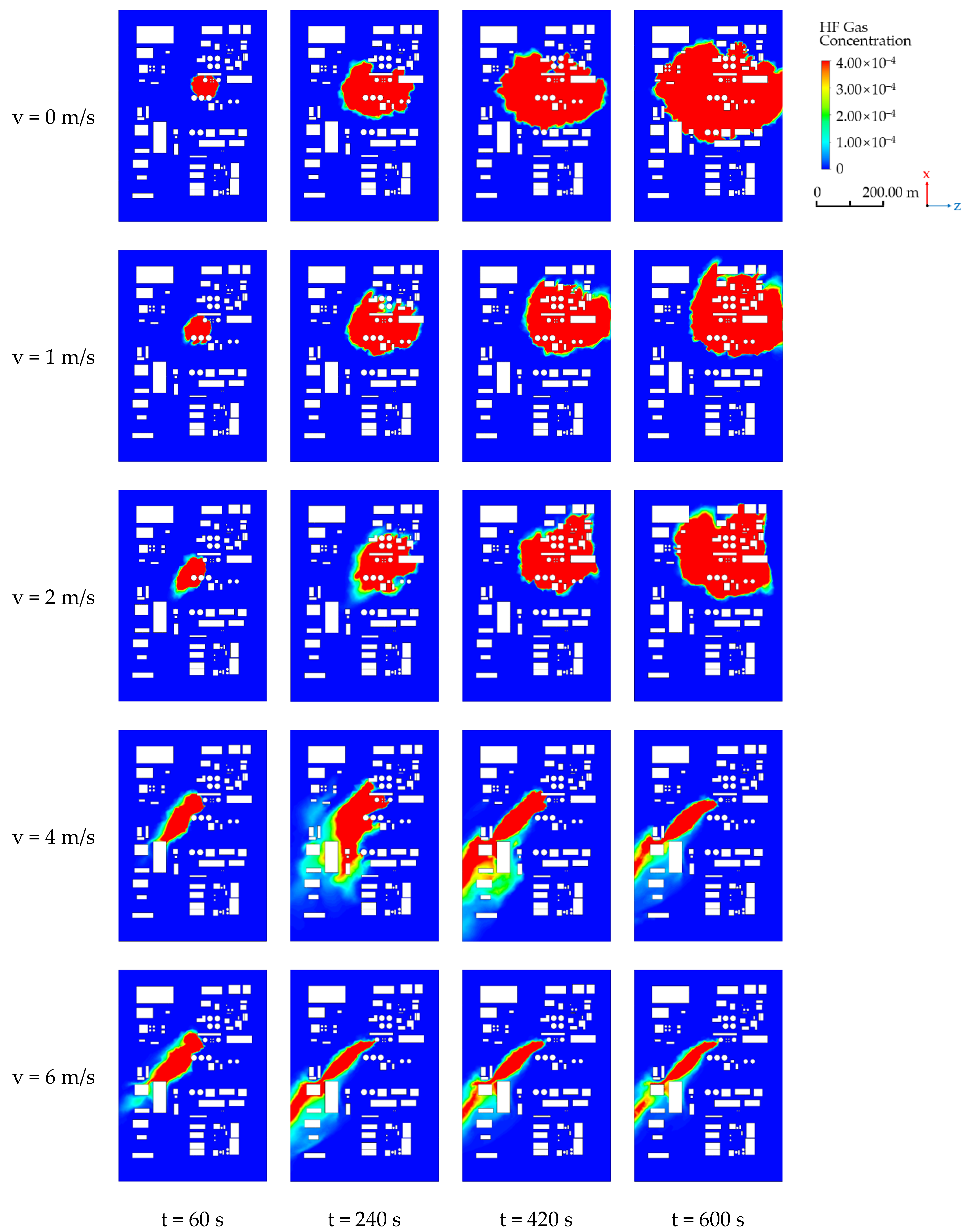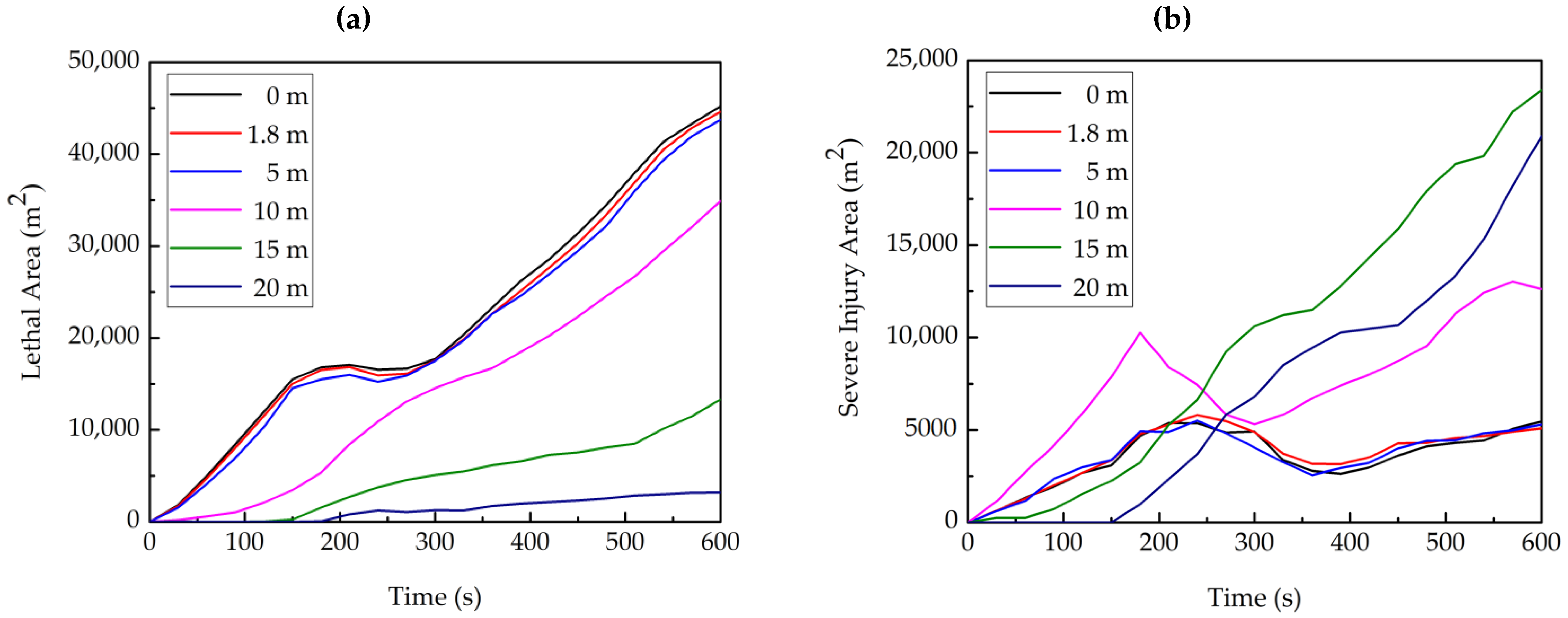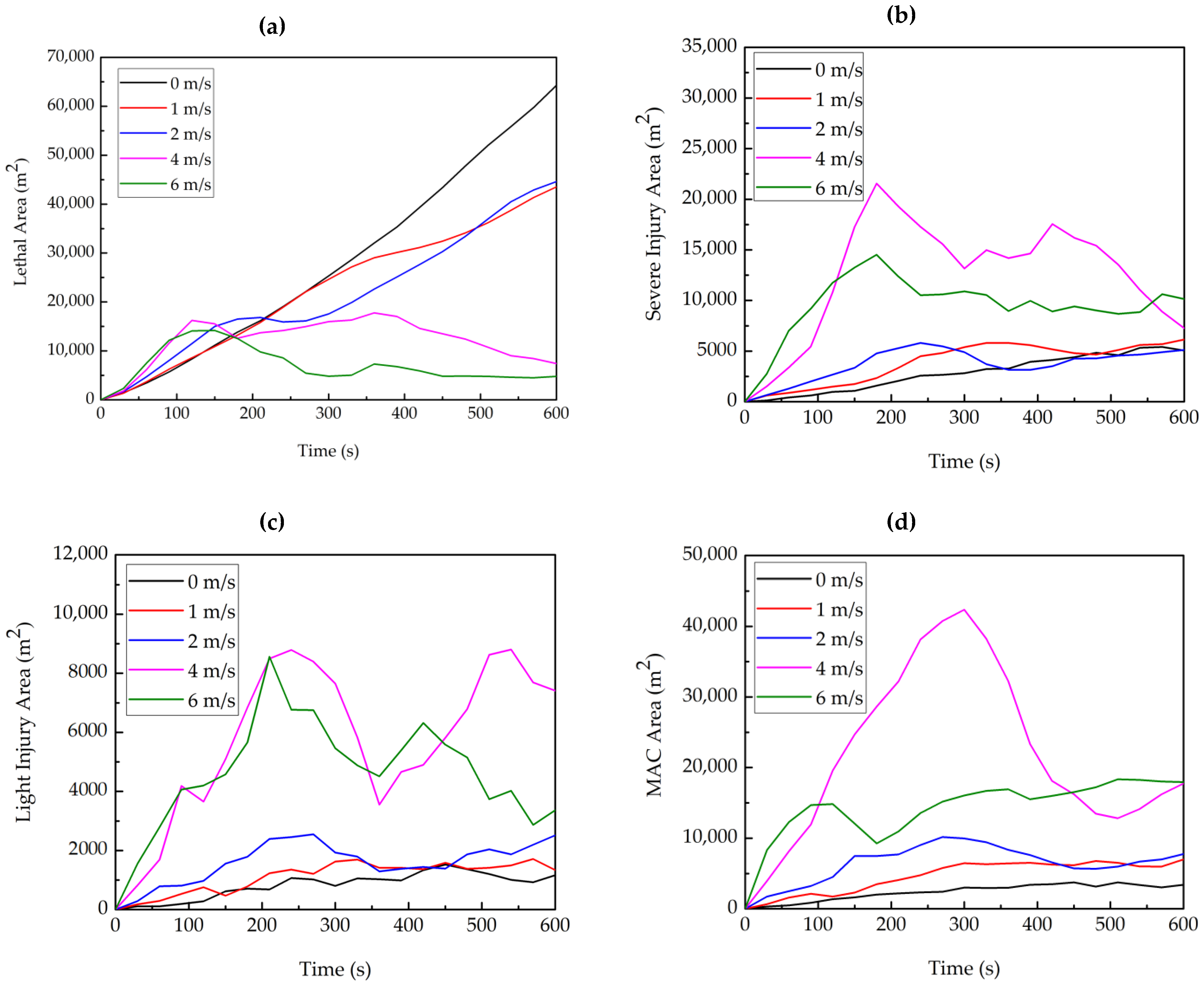Study on Hazardous Areas of Hydrogen Fluoride Diffusion Based on CFD Simulation
Abstract
:1. Introduction
2. Methodology
2.1. Modeling and Verification
2.1.1. The CFD Model
2.1.2. Model Validation
2.2. Simulation Application Background
3. Results and Discussion
3.1. Diffusion Law of HF under Different Wind Speeds
3.2. The Changing Law of Hazardous Areas at Different Heights
3.3. The Changing Law of Hazardous Areas under Different Wind Speeds
4. Conclusions
- When the wind speed is less than 2 m/s, HF diffuses in all directions in a planar shape. When the wind speed is greater than 4 m/s, HF spreads in a downward wind direction in a band. The greater the wind speed, the greater the effect on HF diffusion.
- When the wind speed is 2 m/s and the height is less than 5 m, the change in hazardous areas is almost independent of the height. At 600 s, the lethal area fluctuates within 43,751–45,211 m2, the severe injury area fluctuates within 5088–5458 m2, the light injury area fluctuates within 2065–2514 m2, and the MAC area fluctuates within 7343–8219 m2. When the height is greater than 5 m, as the height increases, the lethal area gradually decreases, the MAC area gradually increases, and the severe and light injury areas first increase and then decrease.
- When the height is 1.8 m and the wind speed is 0–2 m/s, the growth rate of hazardous areas is flat. When the wind speed is 4–6 m/s, the hazardous areas fluctuate greatly. The reason for this difference is that at low wind speeds, HF spreads uniformly in all directions. However, under high wind speeds, HF diffuses in a band shape. The severe injury area, light injury area, and MAC area increase with the increase in wind speed. For the lethal area, the area increases with the increase in wind speed in the range of 0–150 s and decreases with the increase in wind speed in the range of 150–500 s.
Author Contributions
Funding
Institutional Review Board Statement
Informed Consent Statement
Data Availability Statement
Conflicts of Interest
References
- Braun, J.; Stoss, H.; Zober, A. Intoxication following the inhalation of hydrogen fluoride. Arch. Toxicol. 1984, 56, 50–54. [Google Scholar] [CrossRef]
- Peters, D.; Miethchen, R. Symptoms and treatment of hydrogen fluoride injuries. J. Fluor. Chem. 1996, 79, 161–165. [Google Scholar] [CrossRef]
- Rhodes, C.S. Effects of fluorides in animals. Can. Vet. J. 1974, 16, 150. [Google Scholar]
- Stevens, D.P.; McLaughlin, M.J.; Alston, A.M. Phytotoxicity of hydrogen fluoride and fluoroborate and their uptake from solution culture by lycopersicon esculentum and avena sativa. Plant Soil 1998, 200, 175–184. [Google Scholar] [CrossRef]
- Yang, S.; Jeon, K.; Kang, D.; Han, C. Accident analysis of the gumi hydrogen fluoride gas leak using CFD and comparison with post-accidental environmental impacts. J. Loss Prev. Process Ind. 2017, 48, 207–215. [Google Scholar] [CrossRef]
- Ermak, D.L.; Chan, S.T.; Morgan, D.L.; Morris, L.K. A comparison of dense gas dispersion model simulations with burro series LNG spill test results. J. Hazard. Mater. 1982, 6, 129–160. [Google Scholar] [CrossRef]
- Koopman, R.P.; Cederwall, R.T.; Ermak, D.L.; Goldwire, H.C.; Hogan, W.J.; Mcclure, J.W.; Mcrae, T.G.; Morgan, D.L.; Rodean, H.C.; Shinn, J.H. Analysis of burro series 40-m3 LNG spill experiments. J. Hazard. Mater. 1982, 6, 43–83. [Google Scholar] [CrossRef]
- Morgan, D.L., Jr. Dispersion phenomenology of LNG vapor in the burro and coyote LNG spill experiments. J. Heat Transf. 1987, 109, 952–960. [Google Scholar] [CrossRef]
- Rodean, H.C. Effects of a spill of LNG on mean flow and turbulence under low wind speed, slightly stable atmospheric conditions. In Atmospheric Dispersion of Heavy Gases and Small Particles; Ooms, G., Tennekes, H., Eds.; Springer: Berlin/Heidelberg, Germany, 1983; pp. 157–166. [Google Scholar]
- Sklavounos, S.; Rigas, F. Simulation of coyote series trials—Part I: CFD estimation of non-isothermal LNG releases and comparison with box-model predictions. Chem. Eng. Sci. 2006, 61, 1434–1443. [Google Scholar] [CrossRef]
- Rigas, F.; Sklavounos, S. Simulation of coyote series trials—Part II: A computational approach to ignition and combustion of flammable vapor clouds. Chem. Eng. Sci. 2006, 61, 1444–1452. [Google Scholar] [CrossRef]
- Puttock, J.S.; Colenbrander, G.W. Thorney island data and dispersion modelling. J. Hazard. Mater. 1985, 11, 381–397. [Google Scholar] [CrossRef]
- Davies, M.E.; Singh, S. Thorney island: Its geography and meteorology. J. Hazard. Mater. 1985, 11, 91–124. [Google Scholar] [CrossRef]
- Mcquaid, J. Design of the thorney island continuous release trials. J. Hazard. Mater. 1987, 16, 1–8. [Google Scholar] [CrossRef]
- Hartwig, S. Improved understanding of heavy gas dispersion due to the analysis of the thorney island trials data. J. Hazard. Mater. 1985, 11, 417–423. [Google Scholar] [CrossRef]
- Brighton, P.W.M.; Prince, A.J. Overall properties of the heavy gas clouds in the thorney island phase II trials. J. Hazard. Mater. 1987, 16, 103–138. [Google Scholar] [CrossRef]
- Havens, J.A.; Schreurs, P.J.; Spicer, T.O. Analysis and simulation of thorney island trial 34. J. Hazard. Mater. 1987, 16, 139–148. [Google Scholar] [CrossRef]
- Puttock, J.S.; Blackmore, D.R.; Colenbrander, G.W. Field experiments on dense gas dispersion. J. Hazard. Mater. 1982, 6, 13–41. [Google Scholar] [CrossRef]
- Havens, J. Review of dense gas dispersion field experiments. J. Loss Prev. Process Ind. 1992, 5, 28–41. [Google Scholar] [CrossRef]
- Hajji, Y.; Jouini, B.; Bouteraa, M.; Elcafsi, A.; Belghith, A.; Bournot, P. Numerical study of hydrogen release accidents in a residential garage. Int. J. Hydrogen Energy 2015, 40, 9747–9759. [Google Scholar] [CrossRef]
- Kim, E.; Park, J.; Cho, J.H.; Moon, I. Simulation of hydrogen leak and explosion for the safety design of hydrogen fueling station in korea. Int. J. Hydrogen Energy 2013, 38, 1737–1743. [Google Scholar] [CrossRef]
- Malakhov, A.A.; Avdeenkov, A.V.; Toit, M.H.; Bessarabov, D.G. CFD simulation and experimental study of a hydrogen leak in a semi-closed space with the purpose of risk mitigation. Int. J. Hydrogen Energy 2020, 45, 9231–9240. [Google Scholar] [CrossRef]
- Zhou, N.; Cui, W.; Wang, K.; Zhao, H. Numerical simulation analysis of dangerous heavy gas leakage and diffusion. Adv. Mater. Res. 2013, 726–731, 1354–1357. [Google Scholar] [CrossRef]
- Tauseef, S.M.; Rashtchian, D.; Abbasi, S.A. CFD-based simulation of dense gas dispersion in presence of obstacles. J. Loss Prev. Process Ind. 2011, 24, 371–376. [Google Scholar] [CrossRef]
- Fiates, J.; Santos, R.R.C.; Neto, F.F.; Francesconi, A.Z.; Simoes, V.; Vianna, S.S.V. An alternative CFD tool for gas dispersion modelling of heavy gas. J. Loss Prev. Process Ind. 2016, 44, 583–593. [Google Scholar] [CrossRef]
- Wang, D.; Jiang, X.; Ou, Y.; Zhou, J. Numerical simulation analysis on hazardous area of oil gas leakage and dispersion in underground fuel depot. Adv. Mater. Res. 2013, 827, 220–223. [Google Scholar] [CrossRef]
- Dadashzadeh, M.; Khan, F.; Abbassi, R.; Hawboldt, K. Combustion products toxicity risk assessment in an offshore installation. Process Saf. Environ. Prot. 2014, 92, 616–624. [Google Scholar] [CrossRef]
- Souza, A.O.; Luiz, A.M.; Neto, A.T.; Araujo, A.C.; Silva, H.B.; Silva, S.K.; Alves, J.J. A new correlation for hazardous area classification based on experiments and CFD predictions. Process Saf. Prog. 2019, 38, 21–26. [Google Scholar] [CrossRef] [Green Version]
- Barros, P.L.; Luiz, A.M.; Nascimento, C.A.; Neto, A.T.; Alves, J.J. On the non-monotonic wind influence on flammable gas cloud from CFD simulations for hazardous area classification. J. Loss Prev. Process Ind. 2020, 68, 104278. [Google Scholar] [CrossRef]
- Pontiggia, M.; Landucci, G.; Busini, V.; Derudi, M.; Alba, M.; Scaioni, M.; Bonvicini, S.; Cozzani, V.; Rota, R. CFD model simulation of LPG dispersion in urban areas. Atmos. Environ. 2011, 45, 3913–3923. [Google Scholar] [CrossRef]
- Jones, W.P.; Launder, B.E. The prediction of laminarization with a two-equation model of turbulence. Int. J. Heat Mass Transf. 1972, 15, 301–314. [Google Scholar] [CrossRef]
- Shih, T.H.; Liou, W.W.; Shabbir, A.; Yang, Z.; Zhu, J. A new k-ϵ eddy viscosity model for high reynolds number turbulent flows. Comput. Fluids 1995, 24, 227–238. [Google Scholar] [CrossRef]
- Launder, B.E.; Reece, G.J.; Rodi, W. Progress in the development of a reynolds-stress turbulence closure. J. Fluid Mech. 1975, 68, 537–566. [Google Scholar] [CrossRef] [Green Version]
- Blocken, B.; Stathopoulos, T.; Saathoff, P.; Wang, X. Numerical evaluation of pollutant dispersion in the built environment: Comparisons between models and experiments. J. Wind Eng. Ind. Aerod. 2008, 96, 1817–1831. [Google Scholar] [CrossRef] [Green Version]
- Siddiqui, M.; Jayanti, S.; Swaminathan, T. CFD analysis of dense gas dispersion in indoor environment for risk assessment and risk mitigation. J. Hazard. Mater. 2012, 209–210, 177–185. [Google Scholar] [CrossRef]
- Chen, Y.H. Analysis of hazardous and harmful factors of hydrogen fluoride leakage and evaluation of poisoning model. Petrochem. Saf. Environ. Prot. Technol. 2010, 26, 19–21. (In Chinese) [Google Scholar]
- National Health Commission of the People’s Republic of China. Occupational Exposure Limits for Hazardous Agents in the Workplace—Part 1: Chemical Hazardous Agents; GBZ 2.1-2019; National Health Commission of the People’s Republic of China: Beijing, China, 2019; p. 11. (In Chinese)







| Spill Rate (m3/s) | Gas Density (kg/m3) | Air Density (kg/m3) | Wind Speed (m/s) | Ambient Temperature (°C) | Leak Source Diameter (m) | Leak Source Height (m) | |
|---|---|---|---|---|---|---|---|
| GF2 | 0.011 | 2.14 | 1.01 | 4.20 | 36.0 | 0.025 | 2.00 |
| GF3 | 0.011 | 2.20 | 1.04 | 5.40 | 26.5 | 0.025 | 2.00 |
| Simulation Results (×10−5 kg/m3) | Experiment Results (×10−5 kg/m3) | Relative Error | |
|---|---|---|---|
| GF2 | 2.3587 | 1.9396 | 21.61% |
| GF3 | 2.2021 | 1.8596 | 18.42% |
| HF Concentration (×10−6 kg/m3) | Description | Hazardous Area Definition |
|---|---|---|
| 400 | Acute poisoning death | Lethal area |
| 100 | Can only tolerate 1 min | Severe injury area |
| 50 | Skin and mucous membrane irritation | Light injury area |
| 2 | Maximum allowable concentration in occupational exposure scenarios | Maximum allowable concentration area (MAC area) |
Publisher’s Note: MDPI stays neutral with regard to jurisdictional claims in published maps and institutional affiliations. |
© 2021 by the authors. Licensee MDPI, Basel, Switzerland. This article is an open access article distributed under the terms and conditions of the Creative Commons Attribution (CC BY) license (https://creativecommons.org/licenses/by/4.0/).
Share and Cite
Chen, S.; Zhou, Z.; Ma, Y.; Zhang, L.; Wang, T.; Wang, S.; Zhang, Y. Study on Hazardous Areas of Hydrogen Fluoride Diffusion Based on CFD Simulation. Processes 2021, 9, 1545. https://doi.org/10.3390/pr9091545
Chen S, Zhou Z, Ma Y, Zhang L, Wang T, Wang S, Zhang Y. Study on Hazardous Areas of Hydrogen Fluoride Diffusion Based on CFD Simulation. Processes. 2021; 9(9):1545. https://doi.org/10.3390/pr9091545
Chicago/Turabian StyleChen, Siyan, Zhengqing Zhou, Yong Ma, Li Zhang, Tianyi Wang, Shihao Wang, and Yinghua Zhang. 2021. "Study on Hazardous Areas of Hydrogen Fluoride Diffusion Based on CFD Simulation" Processes 9, no. 9: 1545. https://doi.org/10.3390/pr9091545
APA StyleChen, S., Zhou, Z., Ma, Y., Zhang, L., Wang, T., Wang, S., & Zhang, Y. (2021). Study on Hazardous Areas of Hydrogen Fluoride Diffusion Based on CFD Simulation. Processes, 9(9), 1545. https://doi.org/10.3390/pr9091545





